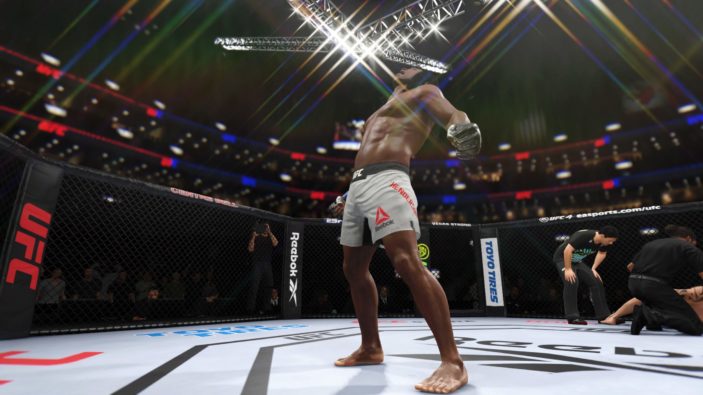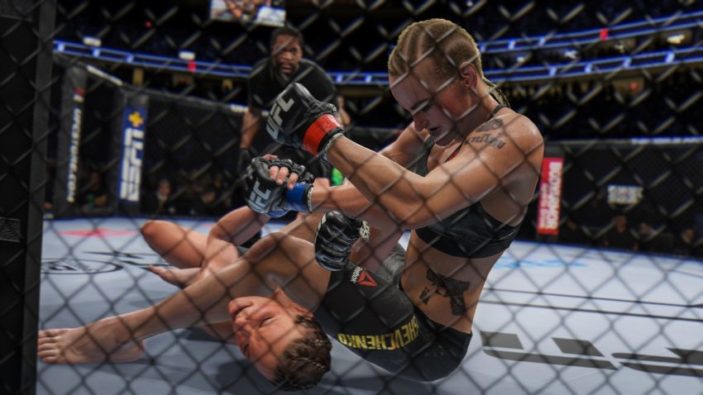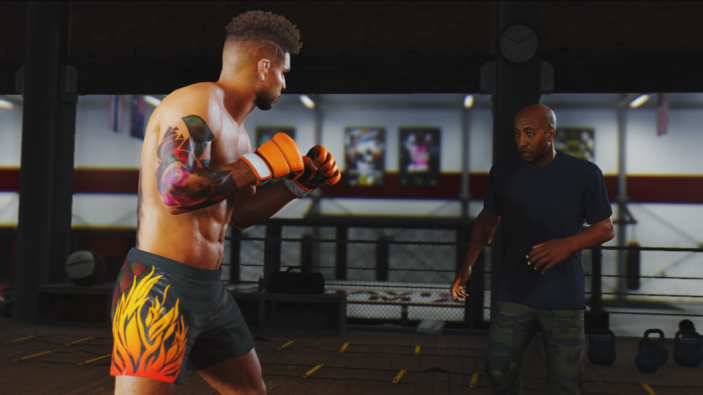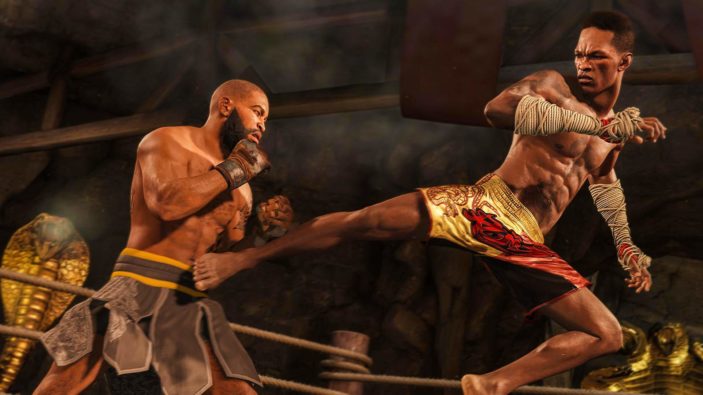
Much of the foundation EA’s UFC series that was laid back in 2014 has developed nicely, but each sequel, while an improvement, felt like an authentic experience that frustrated fans, and alienated others. Solid mechanics and slick visuals impressed, but a clunky ground game left fans like myself, sticking to strikes and knockouts to avoid what can otherwise be described as an awkward encounter. Enter UFC 4. This year’s attempt is in many ways the finest recreation of the sport yet, tweaking last year’s solid gameplay, with an improved, simplified ground game. I can admit it might not be for everyone, but it’s definitely going to attract a larger audience this time around; and that’s never a bad thing.

Round 1. FIGHT!
UFC 4 serves up a multitude of modes to fight your way through, but the heart of any UFC game lies in its combat mechanics; and they’re better than ever. While much of the standing game has carried over from UFC 3, strikes still feel satisfying and weighty, with an added emphasis on striking distance. Much like the Fight Night series, players benefit from appropriate distance. Timed strikes now encourage players to utilise various attacks based on their range, in order to effectively damage and shake your opponent. While this was greatly refined in UFC 3, I felt as though my attention to distance yielded rewarding results, encouraging me to mix up my strikes based on the tactics and approach of my opponent.

Apart from that, the control scheme has largely remained the same. Players can perform a number of strikes and manoeuvres with a combination of face and shoulder buttons. Bobbing and weaving with the right stick can be a little confusing at first, based on both your position and camera angle, but as it’s confined to the one stick, rather than a combination of the stick and shoulder buttons, the learning curve is small.
Takin’ it to the Ground
Unfortunately, the ground game once again leaves much to be desired. Many situations feel unnecessarily daunting, presenting a much steeper learning curve. On the bright side, the clinch game has been simplified, as it’s now much easier to enter and leave a clinch. Initiating a clinch has always been an easy task, but leaving a clinch was such an intense situation in previous games, I could swear I was fighting my controller rather than my on screen opponent. In UFC 4 though, players need only move the left stick away from an opponent to break clinch, provided they have the stamina to do so.
The more traditional ground game looks more accessible at first glance, thanks to a newly implemented grapple assist system. I found that while the game gave me a certain number of options, prompting you to hold the right stick in a certain direction, these moves felt jarring, particularly when your fighter is out of stamina. When you have no choice but to hold the stick in a certain direction to change position or posture, and that move is repeatedly interrupted by your opponent, the game feels like it’s given up on you, almost saying “Well, at least I tried”. There are many options to dominate on the canvas, but none of them feel smooth nor intuitive. In theory, the grapple assist system helps casual fans identify the numerous steps and positions associated with the ground game, but it would have been nice to have an option for recommended moves and manoeuvres that are more likely to work, to save the player scrambling about like a fish out of water.
Submissions however have been improved yet again, with chokes and limb submissions now split into two distinct categories. Each category also comes with its own mini game, adding some much needed diversity to such choices. Chokes require the player to move a small bar around a circle with the left stick, catching and covering your opponents bar in order to complete the submission, while the defender must avoid this bar at all costs. Limb submissions work similarly, but utilise the shoulder buttons. The catch this time around, is that as the defender, randomly moving the bar around makes it larger, and in turn easier for your opponent to submit you. Therefore, each move must be precise and calculated, and this in turn brings an added sense of strategy and tension.

Make Me a Star
UFC 4 career mode doubles as a tutorial, immediately prompting you to create your fighter, as you a thrust into a story in which you are, of course, ‘discovered’ by a local trainer scouting the local fight game. What follows is a string of basic fights which slowly introduce you to the basics, before you find your way into the UFC. Your trainer Coach Davis acts as an obligatory, yet charming invitation to the sport. Interactions with him are frequent and informative, and thanks to some quality voice acting, the relationship built here feels genuine, which is something I never thought I would say about a UFC game. What follows can only be described as the traditional, as you partake in bouts, upgrade your fighter, rinse and repeat. It’s totally passable, and the sense of progression here is frequent and consistent. The grind feels unobtrusive simply because you can feel your training and upgrades adding to each fight, without spending hours upon hours for things to feel even slightly better. Being able to choose and adjust your difficulty level from the beginning also stops later title fights from feeling like the chips are already stacked against you. To add to this, you can even retry a fight after a loss, or live with the consequences for a more authentic experience.

While last year’s Ultimate Team mode is strangely absent, it has at least been replaced with two new arenas; Backyard and Kumite. While the Backyard arena feels pretty run of the mill, it does at least pay respect to some of the rarer success stories that the amateur fight scene is responsible for. It’s also no coincidence that cover athlete Jorge Masvidal rose to UFC fame after many successful backyard fights. The second arena, Kumite, feels like a mode all of it’s own. I can only imagine that EA Vancouver were sitting around a table one day, discussing new modes, only for one of them to mention, “You know what this game needs? A taste of the iconic Jean-Claude Van Damme film Kickboxer”. This is truly a bizarre mode, but it fits perfectly, as though the over the top sound effects, dramatic music and simplistic mechanics will surely draw in many casual fans. The arena also does away with intricate stamina and health systems, in favour of an old school health bar. It’s pretty much a basic fighter, but you can feel the effort that has gone into what is otherwise an unnecessary mode. In saying that however, I strongly recommend new fans of the series jumping into the Kumite arena for a few rounds before stepping into the more nuanced feel of the octagon.
UFC 4’s Blitz Mode is also a completely new mode that brings fast frenetic fun to online play. Here, the rules of each fight constantly change, encouraging you to shake up your approach in order to stay on top. Whether it’s shorter rounds, or a best of three knockout scenario, I can see the Blitz Mode holding the attention of veteran and causal fans alike, thanks to its fast paced nature.

Overall Thoughts
UFC 4 is in many ways, the best UFC game to date. But not for the reasons you might think. While the ground game needs work, striking feels better than ever. While the career mode provides nothing new, interactions with Coach Davis add a sense of heart and charm. While Ultimate Team is gone, the Kumite arena has added a casual layer to this experience I never knew I wanted. Everything that counts feels fleshed out, while everything that never really worked got the boot, resulting in an experience that feels more focused on pleasing hardcore and causal fans alike. There’s a mode for everyone, and the octagon is waiting.
FOUR STARS (OUT OF FIVE)
Highlights: Solid striking mechanics; Intuitive and accessible career mode; Kumite arena is a blast
Lowlights: Muddled ground game
Developer: EA Vancouver
Publisher: EA Sports
Platforms: Playstation 4, Xbox One
Available: Now
Review conducted on Playstation 4 with a retail code provided by the publisher.
